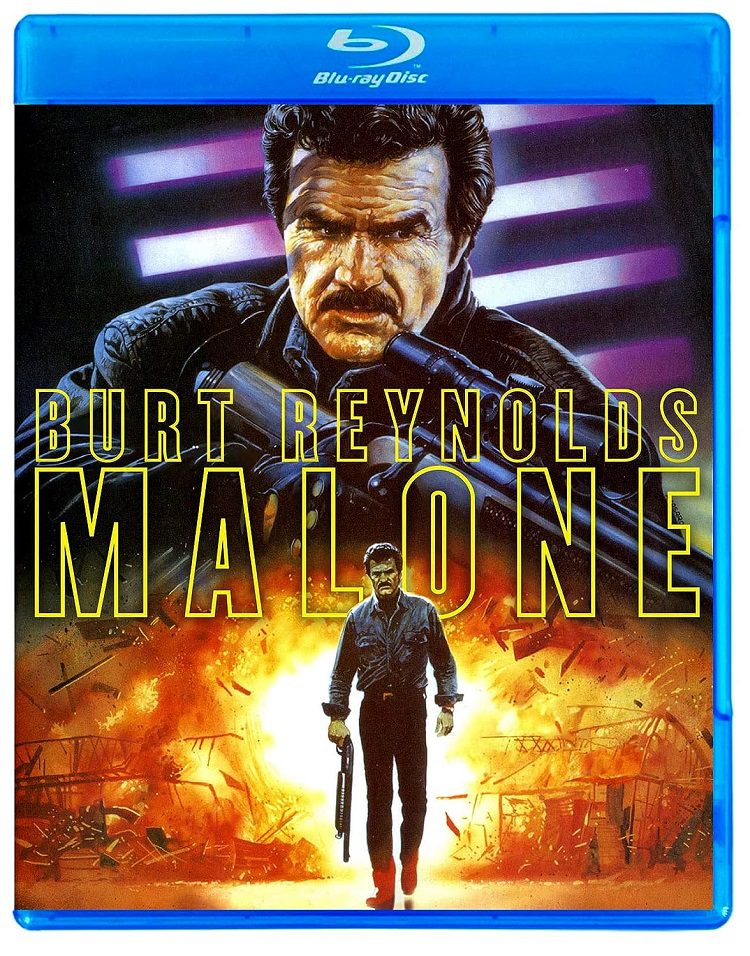
Burt Reynolds is Malone. But in 1987 that didn’t mean as much as it did back in the ’70s when Burt Reynolds was Gator and Hooper and the Bandit. During the ’80s, Reynolds starred in a string of box-office duds starting with Stroker Ace (1983), which loyalty to director Hal Needham led him to choose over the role that Jack Nicholson won an Oscar for in Terms of Endearment. By the end of the decade,the industry and the movie-going public no longer considered him a box-office draw. In the ’90s, he revived his career by starring on the hit sitcom Evening Shade for which he won the Outstanding Lead Actor in a Comedy Series Emmy twice and moving on to supporting roles in critically acclaimed films, such as Citizen Ruth and Boogie Nights, which earned him his first Oscar nomination.
Based on William P. Wingate’s Shotgun, Malone was made during Reynolds’ career decline. It’s easy to see why it doesn’t stand out in his filmography as it’s a generic retelling of a common story about an outsider coming to a town bullied by a bad guy and freeing them from their oppression. Malone is a disillusioned CIA assassin who leaves the company. He ends up in rural Oregon when his car breaks down. Local mechanic Paul Barlow (Scott Wilson) helps him, but he needs time to order the parts. Malone is willing to wait. Paul offers his spare room, and they bond over their ‘Nam experiences although Malone’s work took him into the country early.
Paul’s daughter Jo (Cynthia Gibb) doesn’t trust Malone initially, but quickly grows quite fond of him. It’s slightly awkward because it’s not clear how old she is. She comes across as a teenager, but her father doesn’t say anything, so presumably she’s of age.
Charles Delaney (Cliff Robertson) is buying up property in the area and won’t take “no” for an answer. He seems like the typical greedy businessman with the sheriff under his control and influential political ties; however, he’s a white supremacist and is buying the land for his terrorist organization. He is the most interesting character of the story.
Delaney’s goons try to scare off Malone to no avail. And it’s not only Delaney that Malone has to worry about. The CIA sends his former associate Jamie (Lauren Hutton) to kill him. The movie concludes as expected, with Malone working his way through Delaney’s hired goons before their final confrontation.
Malone’s confrontations with Delaney’s henchmen are the best sequences in the movie. There are entertaining kills and the viewer gets to see a defiant Reynolds. He has a few scenes with Hutton where his character gets to be lighthearted and Reynolds’ natural charm can’t help but shine.
The video has been given a 1080p/MPEG-4 AVC encoded transfer displayed at the movie’s original aspect ratio of 1.85:1. During the opening credits and establishing shots, the image is filled with marks and dirt. Throughout the movie, marks of black or white are apparent. Earth tones appear in rich hues. Blacks are inky but crush at times. Exterior sunlight into a building can bloom as seen with Delaney’s barn. Some scenes have too much grain, such as when Malone and Delaney first meet, making it look like scurrying insects. This impacts the detail and depth.
The audio is available in DTS-HD Master Audio 2.0. Dialogue is clear. Composer David Newman’s score sounds robust and amplifies a scene’s emotion. Ambient effects add realism to scenes. Explosions and gunfire blast away with sufficient power.
The special features are an audio commentary by film historians Steve Mitchell and Nathaniel Thompson and trailers for seven Burt Reynolds films in the KLSC library.
Malone finds Reynolds showing off a particular set of skills. It’s just a shame screenwriter Christopher Frank’s set of skills didn’t deliver a better script because the movie plods along between action scenes. It’s a fine shoot-’em up, but not a genre standout. The high-definition presentation is satisfactory, although the film source needs to be cleaned up.